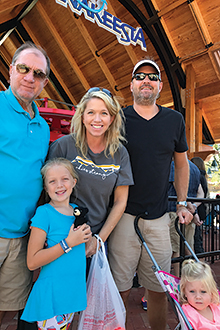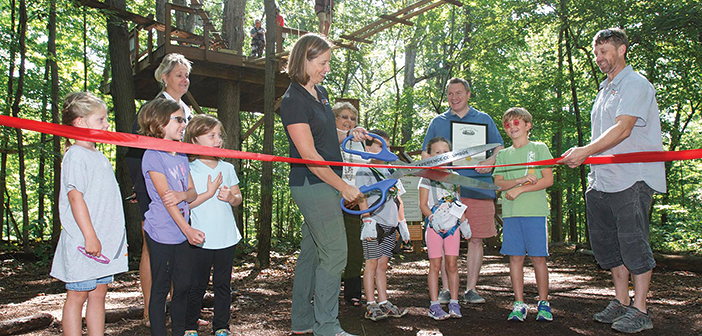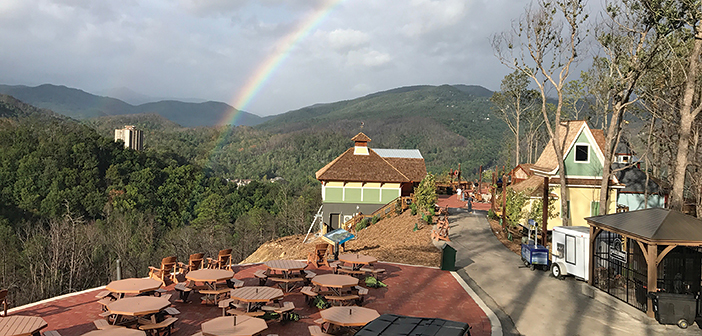You ran the numbers, toured numerous other parks, secured the financing, broke ground, shed blood, sweat, and tears (maybe literally) along the way, and finally, you’ve made your business development dreams come true—your adventure park is up and running. Now what?
Whenever your business is running smoothly, it’s tempting to kick back, take a breather, and let the business run itself for a while. But don’t rest for more than a brief interlude. This is the time to plan for the next phase of business development.
The fact is, competition is knocking at your door, and your visitors will eventually get bored with what you currently offer. I know what you’re thinking: how could anyone get bored with this amazing park that took so much hard work to build and get off the ground? To quote Doug from the movie Up!: “SQUIRREL!!!” In other words, people are easily distracted by the next great thing. If you aren’t looking to constantly change and innovate, your park may soon be forgotten.
So, let’s not sit around waiting for something to happen. Whether you just opened last month or have been operating for several years now, it’s time to get planning. Here’s what that looks like.
A long-range plan has three major components to it:
1. a situation analysis
2. your goals for the future
3. your strategy to get there

When weighing what features to include in a new park, or what features to add, activities for kids, like the Treehouse Village playgound at Anakeesta, should be tops
on the list.
Part 1: Situation Analysis
This may sound like a formal undertaking, but it’s really quite simple. Here are the questions that you need to ask yourself for your situation analysis.
1. Where have we been?
You’ve heard the old adage, that those who ignore history are doomed to repeat it. It’s true. So take heed, and look back at the history of your company and the projects you’ve undertaken. Has business been growing? Has the growth rate slowed down or stalled? Consider what you’ve tried before, how long it took compared to your original estimates, and how accurate your cost and revenue estimates were. For example, if the timeline of your build process was off by 20 percent, that is good data to incorporate into any expansion plan.
2. Where are we now?
Consider your staffing, revenues, profitability, and your overall operation. How well are you handling your current customer volume? Are you providing the guest experience you aim for? This reflection will help you figure out what resources must be acquired if you wish to start a new project. These resources include cash, people, materials, and financing.
Speaking of financing, you should take a close look at the condition of your financial statements to see if there is anything that needs to be cleaned up before you go looking for money. For example, if you have any debt, what is the nature of it? In which months are you cash flow positive, when are you breaking even, and are there times when you’re losing money? If there is a loss, is it seasonal or due to other factors? While you’re at it, it’s also not a bad idea to check your business credit score (yes, that does exist). Financial institutions will scrutinize your financial statements, and you will want to be ready and able to explain how your expansion plan will increase your business.
3. Where do we want to go?

Consider the multi-generational families who could be your customers.
This is where you start to look to the future and create a vision for what you want your business to become. Whether you are looking to add new attractions or services, open up additional locations, or simply make some operational changes that add value, the more specific you can be about what that future looks like, the easier your planning will be.
4. Why do we want to go there?
I know, I know. You want to get to the HOW part! But answer “why” first. In his book, “The Answer to How is Yes,” Peter Block argues that before you consider how to do something, you should consider why you want to do it. Asking almost anything other than how will help you see if what you are planning really makes sense for you. Remember, just because you can do something, doesn’t mean that you should—or that the payback will be worthwhile.
So, ask yourself: Why am I looking to change? Is the change customer-focused? Will it help increase profits? Is there an audience for it? Do I have competition knocking on the door? Do my changes align with the company’s mission and vision?
And that leads us to our next point:
5. What are our core values?
Reviewing your core values can help you set the direction for your project. For example, we often come across prospective clients that want to add a commercial attraction to their educational-based programs. I’m not going to say if that’s right or wrong—there are plenty of examples where this has made sense—but it’s different for everyone. Reviewing your core values will help determine what is right for you and your business.
Part II: Your Goals
If you don’t know where you’re going, how will you know how to get there? The planning process is, at its core, setting and achieving goals. Looking back at our situation analysis, let’s first consider our vision of where we want to go and why we want to go there. This will influence our long-term goals.
Long-term goals are milestones on the way to achieving your vision for your business. What milestones are you going to pursue? Let’s say, for example, you want to create a chain of aerial parks across the U.S. Your long-term goals may include opening five new parks in your region, then 10 new parks on your side of the Mississippi, followed by 20 new parks across the nation, and finally selling the business for a large chunk of CASH.
These are fairly definitive (albeit lofty) goals that can be measured pretty easily. But let’s look at some other measures of success that will influence how these goals can be achieved.

Adding a ropes course and kids play area to the existing zip line canopy tour at ZipZone, Ohio, was the result of careful planning.
1. Measures of Success
Each long-range plan will have its own goals, and therefore its own measures of success. In our lofty example, your project will need to measure things such as employee turnover, visitor repeat rate, marketing performance, and, of course, profitability.
Perhaps you determine that before your plan moves to the next phase of development, your existing parks must have an annual employee turnover rate of 40 percent or lower, 50 percent of your visitors come back at least once per season, you are making at least twice the ROI for your marketing efforts, and your profit margin is at least 25 percent. These are hypothetical numbers, of course, but are meant to illustrate some of the key factors that should be considered.
2. Potential Obstacles
It is also critical when making long-term goals to examine the potential obstacles that you may encounter along the way. In the case of our national chain of parks, some of our obstacles may be:
• competition entering the market
• major changes in technology
• new state and federal regulations
• a change in construction and operational standards
• an economic downturn
None of these are preventable, so you’ll need a plan for dealing with them if and when they arise—as they most likely will at some point. Take the time to sit down and consider each potential obstacle, one by one. Make a list of every possible solution, and then narrow that list down to three or four realistic, potential solutions.

Before putting a shovel in the ground, ask yourself, “Where do we want to go?” Here, a rendering of the master plan for Bogus Basin, Idaho, helps map that out.
Part III: Your Strategy to Get There
Now that you know where you want to go and have set goals for major milestones to achieve along the way, it’s time to put your strategy together. Here are some important factors to consider as you create your strategy:
1. Stakeholders
Identify and communicate with all stakeholders in the project. Stakeholders may include partners, investors, landowners, and current staff. Failing to include someone at the start of the project can, at best, cause delays later in the process. At worst, it can derail the entire thing. On the plus side, your stakeholders may well have some valuable ideas of their own.
2. Resources needed
List all of the resources (that you know of) needed to meet your project goals. These may include staff, builders, materials, legal, accounting, and of course, time. If there is a resource that you need but don’t have, determine what must be done to acquire it, and factor that into your plan.
3. Financing
While “funds” are a resource, financing is so vitally important that it deserves its own place in your strategy. To start, you must figure out how much money you’ll need to complete the project, and also when you will need it. It’s rare that a project uses all of the needed funds at once. Putting together a funding calendar will help prepare you for that next outlay of funds. Always start the funding process sooner than you think you’ll need it. Of all of the components in a project, funding is the least predictable. And if the word “financing” makes you want to run and hide under a rock, hire someone who can help you through
the process.

New technology and attractions are always coming to market, like this single rail coaster.
4. Implementation
Detail all of the stages of your project, and the steps in each stage. We like to use a tool called a Gannt chart to track all of the elements of the project. You can build one in Microsoft Excel, and there are some great apps and browser add-ins that you can use as well.
Along with each step, assign an individual to be responsible for implementing it. This person isn’t necessarily the one doing the work, but is in charge of making sure it gets done.
Also, assign a deadline for each step, and identify the actions and moves that contribute to achieving that deadline. By breaking down these steps, you should be able to adjust the timeline of your plan when you experience delays. (Does any of this seem familiar?)
5. Project oversight
Someone has to be in charge of ensuring that all the timelines are met, and update the Gantt chart accordingly. He or she will also need to communicate the project’s status to the entire team working on it. Larger companies often opt to hire a project manager, while smaller companies typically rely on an internal staff member. If you are the owner/manager of an aerial adventure park, that person will probably be you.
The Bottom Line
While long-range planning may sound like a lot of work, by simply entertaining the idea, you are already ahead of the game. We’ve seen businesses struggle because they got complacent and didn’t think (and plan) ahead. Whether you really do have ambitions to take over the global adventure park market, or simply want to add to your offerings and build an additional revenue stream, walking through and applying this process to your business are the first steps in long-range planning.
And remember, if you are looking to expand, it’s not your first rodeo. Your experience to date is an invaluable resource that will help you along the way. You have plenty of other resources in place, too. So don’t sweat it, take it one step at a time, and follow the road map in front of you.
Oh, and remember to take a break every so often to actually enjoy the park that you built.

It takes time and effort, but creating a long-range plan for your park will, hopefully, help you find gold at the end of the rainbow.






